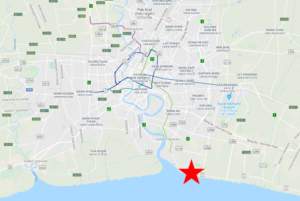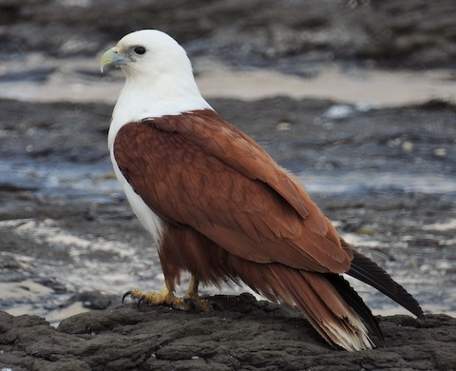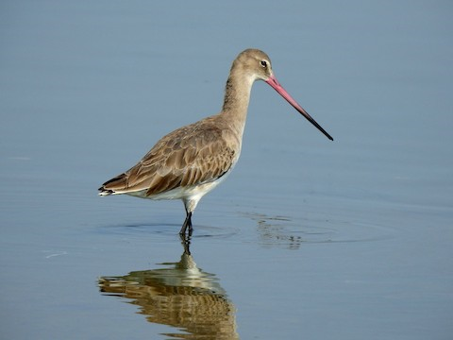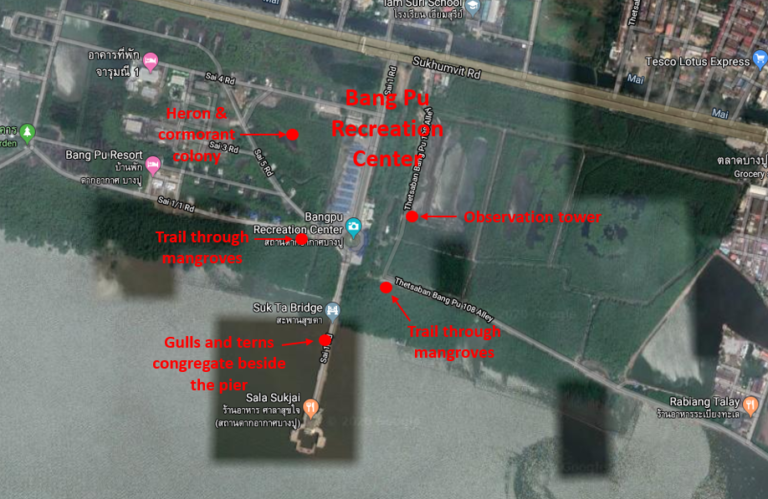Bang Pu Recreation Center, Samut Prakan, Thailand

A traditional favorite of Bangkok-based birdwatchers, Bang Pu is known as a migration hotspot with a history of attracting interesting vagrants. Flocks of gulls and terns swarm beside its pier, wading birds of all sizes congregate in sheltered lagoons, and songbirds flit through the mangroves, all in a compact area that has been developed for bird observation. For foreign birdwatchers, its value depends on which other coastal sites are on the itinerary—apart from the gulls, most of the expected species can be found as easily elsewhere.
Orientation
Directions
Bang Pu is on the coast of Samut Sakan about 40 km south of downtown Bangkok, accessed directly from the main coastal highway, Route 3 (a.k.a. Sukhumvit Road). When driving to Bang Pu southbound, you will be in the northern lanes, so it is necessary to go about 200 m past the entrance road, and make a U-turn, then turn left onto the property.
Reaching Bang Pu by public transportation is fairly simple. Take the Green Line to its southern terminus, Kheha Station, then go to the adjacent bus stop on the east side of Sukhumvit Road and take any southbound city bus for approximately 6 km to the entrance to Bang Pu.
Birdfinding
Bang Pu has several points of interest for bird observation: (1) the pier, (2) an observation tower overlooking a large lagoon, (3) a waterbird nesting colony, and (4) two short nature trails through the mangroves.
The Pier. Near the base of the pier on its western side, there is a formation of pilings that attracts many gulls and terns. Three species of gulls normally occur: Brown-headed, Black-headed, and Slender-billed. Several other species occur as frequent vagrants, including: Mew (the Kamchatka form), Pallas’s, Black-tailed, Heuglin’s, Caspian, and Lesser Black-backed. Most of the terns will be Whiskered, sometimes with a few White-winged and Common (the Siberian form) mixed in, and very rarely Black-naped or Great Crested.

Brahminy Kite is a regular sight at Bang Pu. © Steven McBride
At low tide, when the mudflats beside the pier are exposed, a few shorebirds can be seen from the pier, although most will be at long range.

Brown-headed is the predominant gull species beside the pier at Bang Pu, where this one was photographed. © Ben Weil

Slender-billed Gull is a regular winter visitor beside the pier at Bang Pu. © Brian Carruthers
The Tower. The eastern half of the property contains three large mangrove-lined lagoons that are mostly concealed from observers, with the exception of an excellent observation tower at the southwestern corner of the western lagoon. Large congregations of shorebirds occur in the lagoons at high tide. In winter, Black-tailed Godwit (the Siberian form) is usually the predominant species, but many others occur in smaller numbers. Many other shorebird species occur in smaller numbers, often including: Pacific Golden-Plover, Lesser Sand-Plover, Whimbrel, Eurasian Curlew, Great Knot, Curlew, Common, Marsh, and Wood Sandpipers, Common Redshank, and Common Greenshank—with many others that occur irregularly. Larger waders present often include a flock of Painted Storks, in addition to the usual egrets and pond-herons.

The Siberian form of Black-tailed Godwit is usually the predominant shorebird at Bang Pu. © John Sandve

The Nesting Colony. The western side of Bang Pu is a residential resort for military officers and their families, but other visitors are allowed in. At the entrance, the road forks. Keeping right (on Sai 5) will bring you to an open patch of mangroves where both resident cormorant species (Little and Indian) and a few species of heron (mainly Black-crowned Night-Heron) nest.
Mangrove Trails. There are two elevated walkways through the mangrove forest. Birds typically observed along them typically include Golden-bellied Gerygone, Common Iora, and Swinhoe’s White-eye. In winter, Black-naped Monarch, Yellow-browed and Dusky Warblers, and Asian Brown and Taiga Flycatchers can often be found along these trails.
Other Trails and Roads. The eastern side of Bang Pu is mostly mangrove forest divided by roads that are accessible only to official vehicles, and therefore serve mainly as walking paths. The western side is a pleasant resort neighborhood with similar natural habitat augmented by gardens. Additional birds that are likely to be seen while walking the roads include: Brahminy Kite, Greater Coucal, Blue-tailed Bee-eater, Black and Ashy Drongos, Brown Shrike, and Racket-tailed Treepie.

Golden-bellied Gerygone is a common resident of the mangroves at Bang Pu. © Tom Benson
Notes
When to Visit
Bang Pu is most interesting during migration periods, especially from September into December, when unusual waterbirds are most likely to turn up. There is another activity peak in the spring, mainly during March and April.
Links